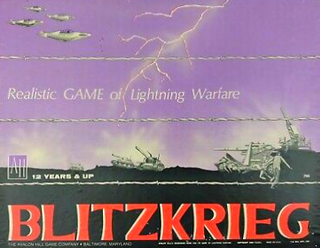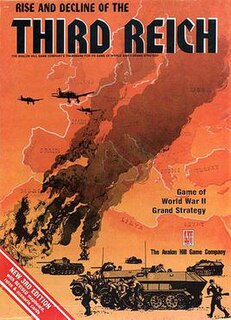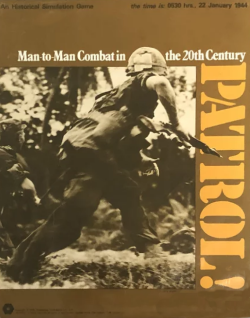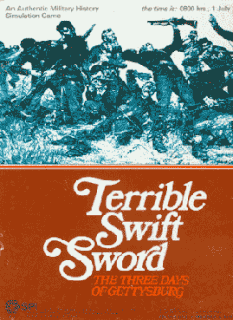
A wargame is a game that realistically simulates warfare, as opposed to abstract games such as chess. Wargaming may be played for recreation, to train military officers in the art of strategic thinking, or to study the nature of potential conflicts. Many wargames recreate specific historic battles, and can cover either whole wars, or any campaigns, battles, or lower-level engagements within them. Many simulate land combat, but there are wargames for naval and air combat as well.

Axis & Allies is a series of World War II strategy board games. The first version was first published in 1981 and a second edition known colloquially as Axis & Allies: Classic was published in 1984. Played on a board depicting a Spring 1942 political map of Earth divided by territories, players take the role of one or more of the five major belligerents of World War II: the Axis powers of Germany and Japan; and the Allied powers of the Soviet Union, the United Kingdom, and the United States. Turn rotates among these belligerents, who control armies of playing pieces with which they attempt to capture enemy territories, with results determined by dice rolls.

Miniature wargaming is a form of wargaming in which military units are represented by miniature physical models on a model battlefield. The use of physical models to represent military units is in contrast to other tabletop wargames that use abstract pieces such as counters or blocks, or computer wargames which use virtual models. The primary benefit of using models is aesthetics, though in certain wargames the size and shape of the models can have practical consequences on how the match plays out. Miniature wargaming is generally a recreational form of wargaming because issues concerning scale can compromise realism, making it unsuitable for most serious military applications.
Advanced Third Reich is a board wargame originally designed by Bruce Harper as a simulation of the European and African theatres of World War II. The game was published by Avalon Hill, who then sold the license to Hasbro, and was marketed as "the ultimate World War II strategy game". Advanced Third Reich is a rewrite of Rise and Decline of the Third Reich (1974), incorporating and developing many suggestions which had been published in The General since the early 1980s, improving ease of play and historical realism.

Advanced Squad Leader (ASL) is a tactical-level board wargame, originally marketed by Avalon Hill Games, that simulates actions of squad sized units in World War II. It is a detailed game system for two or more players. Components include the ASL Rulebook and various games called modules. ASL modules provide the standard equipment for playing ASL, including geomorphic mapboards and counters. The mapboards are divided into hexagons to regulate fire and movement, and depict generic terrain that can represent different historical locations. The counters are cardboard pieces that depict squads of soldiers, crews, individual leaders, support weapons, heavy weapons, and vehicles.
Avalanche Press is an American company that publishes board wargames and has published some role-playing game supplements. They have produced The Great War at Sea and Panzer Grenadier series, as well as Red Parachutes, one of their earliest games and a detailed study of the Soviet crossing of the Dnepr River in 1943.

PanzerBlitz is a tactical-scale board wargame of armoured combat set in the Eastern Front of the Second World War. The game is notable for being the first true board-based tactical-level, commercially available conflict simulation (wargame). It also pioneered concepts such as isomorphic mapboards and open-ended design, in which multiple unit counters were provided from which players could fashion their own free-form combat situations rather than simply replaying pre-structured scenarios.

Blitzkrieg is a strategic-level wargame published by Avalon Hill in 1965 that simulates a non-historical attack by one major power against another using blitzkrieg strategy. It was the first commercial wargame that did not simulate an actual historical battle, and with almost 400 counters, it was a precursor of the "monster" wargames of the 1970s featuring more than a thousand counters.

Rise and Decline of the Third Reich or more commonly Third Reich is a grand strategy wargame covering the European theater of World War II, designed by John Prados and released in 1974 by Avalon Hill. Players take on the roles of major powers—Germany, Italy, United Kingdom, France, the Soviet Union, and the United States—from 1939 to 1946.

Patrol, subtitled "Man to Man Combat in the 20th Century", is a skirmish-level board wargame published by Simulations Publications Inc. (SPI) in 1974 as a sequel to Sniper!, which had been released the previous year. Whereas Sniper! was set in urban environments during the Second World War, Patrol is set in a non-urban environment, in various conflicts ranging from 1914 to 1970.

Tactical wargames are a type of wargame that models military conflict at a tactical level, i.e. units range from individual vehicles and squads to platoons or companies. These units are rated based on types and ranges of individual weaponry. The first tactical wargames were played as miniatures, extended to board games, and they are now also enjoyed as video games.

Hitler's War is a strategic level World War II war game for 2 or 3 players, first published by Metagaming Concepts in 1981, and then by Avalon Hill in 1984.

Terrible Swift Sword: The Three Days of Gettysburg is a classic grand tactical, regimental level board wargame depicting the Battle of Gettysburg of the American Civil War. It was published by Simulations Publications, Inc. (SPI) in 1976, and remains one of the largest board wargames ever produced.
The Great War at Seaseries of board wargames released by Avalanche Press features operational and tactical-level naval combat in the period of the early battleships and dreadnoughts. Each game in the series comes with a common rule book and tactical map, as well as game-specific operational map, counters and scenarios.
Second World War at Sea is a game series produced by Avalanche Press covering naval combat during World War II. The series is based on Avalanche Press' Great War at Sea. The two series share many features although they are separate both from a rules standpoint and a scale standpoint.
The Panzer Grenadier series of board wargames is Avalanche Press's series of World War II and The Korean War tactical land combat. The first game in the series was released in 2000.

Gary Grigsby's Pacific War is a 1992 strategy wargame released by Strategic Simulations, Inc.. It covers World War II in the Pacific between the Japanese Empire and the Allies, which include the United States, the British Empire, the Netherlands, Australia, New Zealand, Canada, the Philippines, and China. The main map of the game stretches from north of the Aleutians to southern New Zealand and Australia, and from the eastern coast of India to the West Coast of North America. It includes aircraft carrier operations, amphibious assaults, surface bombardments/engagements, strategic bombing, kamikazes, and the submarine war against naval and merchant shipping.
I Ain't Been Shot Mum! is a World War II tabletop skirmish miniatures wargame produced by Too Fat Lardies.

Highway to the Reich is a grand tactical monster board wargame published by Simulations Publications, Inc. (SPI) in 1976 that simulates the World War II Allied operation known as Operation Market Garden.